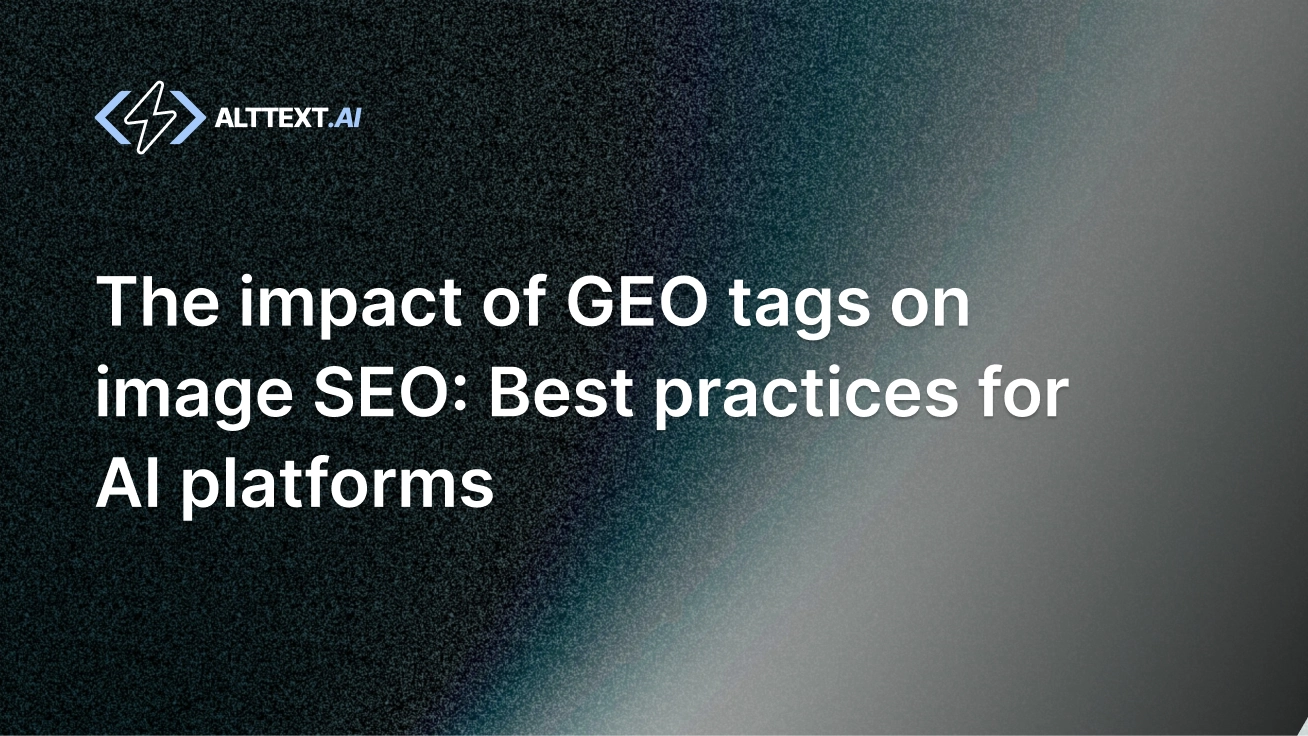
The Impact of GEO Tags on Image SEO: Best Practices for AI Platforms
How location metadata can enhance your visual content's search performance
When it comes to image SEO, most people think of alt text, file names, and compression. But there's one powerful, often overlooked strategy that AI platforms can leverage to improve search visibility—GEO tagging.
For AI companies that process, generate, or optimize visual content (like AltText.ai), embedding location metadata into images can enhance your content's discoverability in local search results, drive traffic from geographically relevant users, and build stronger topical authority.
In this post, we'll break down what GEO tags are, why they matter, and how AI platforms can use them to boost SEO performance—especially for local and regional targeting.
What are GEO tags in images?
GEO tags (or geotags) are metadata elements embedded in image files that contain location-specific information, such as:
- Latitude and longitude
- Altitude
- Place names (city, region)
- GPS timestamp
They're typically added via EXIF (Exchangeable Image File Format) data and can be viewed or edited using tools like Adobe Lightroom, GeoImgr, or various AI-driven media platforms.
Why GEO tags matter for SEO
Search engines, especially Google, use a wide range of signals to understand context. GEO tags help provide location context for your images, which can:
- Improve visibility in Google Images and local map packs
- Help associate your content with specific regions or cities
- Strengthen your local SEO signals, especially when paired with structured data and GEO-targeted content
- Support voice search and visual search accuracy
Fact: Google prioritizes local relevance in mobile image searches, making geotagged visuals more likely to appear in location-specific queries like "ADA-compliant product pages in NYC."
Who should use GEO tags?
GEO tagging isn't just for travel bloggers and real estate listings. AI companies that work with images at scale, like AltText.ai, can benefit too, especially if you:
- Serve local or regional clients
- Generate or optimize large image libraries for eCommerce, publishing, or compliance
- Want to build location authority for SEO purposes
- Are embedding custom alt text for clients based on their geographic market
Assess Your Local SEO Image Gap
Before implementing GEO tagging and optimized alt text for local markets, run a free Website Accessibility Analyzer to understand your current local SEO image optimization opportunity.
How to add GEO tags to images: a step-by-step guide
1. Use an EXIF Editor
Use tools like GeoImgr or Adobe Lightroom to manually or automatically add latitude/longitude coordinates to images.
2. Automate at scale (AI Tools)
For AI platforms managing thousands of images, GEO tagging can be incorporated into image processing workflows using APIs or batch tagging tools.
For example, you can:
- Pull location data based on client location or regional metadata
- Programmatically embed geolocation tags during image optimization
3. Pair with Alt Text and Structured Data
GEO tags work best when combined with:
- Descriptive alt text (e.g. "Toronto-based AI-powered dashboard example")
- LocalBusiness schema or
ImageObjectschema - SEO-friendly filenames (e.g.
ada-compliant-page-vancouver.png)
4. Keep compliance in mind
Not all images should be GEO tagged—especially user-generated content or sensitive data. Ensure tagging is appropriate for your privacy policies and audience.
Best practices for AI platforms using GEO tags
| Best practice | Why it matters |
|---|---|
| Tag images with accurate locations | Prevents misleading metadata or SEO penalties |
| Use tags aligned with content topics | Reinforces keyword + location pairings |
| Combine with location-rich alt text | Improves contextual match for image search |
| Create location-targeted image sets | Supports local landing pages and campaigns |
| Store tagged images in SEO-optimized folders | Helps search engines index images contextually |
Real-world example: how GEO tags support SEO
Let's say AltText.ai supports a Shopify store in Austin, TX with over 5,000 images. By optimizing image alt text and adding GEO tags tied to Austin:
- Images rank better for "ADA-compliant Shopify store in Austin"
- Local traffic increases to product pages with optimized visuals
- Search engines associate AltText.ai with location-based accessibility solutions
How GEO tags help AI models serve better results
Language models like ChatGPT, Gemini, and Perplexity AI surface content based on context clues like location, keywords, and media metadata.
When images contain structured alt text and GEO metadata, they:
- Have a higher chance of being referenced or cited in localized queries
- Become more relevant for AI-generated summaries or product recaps
- Help LLMs "understand" that your content applies to a specific audience or region
FAQ: GEO tags and image SEO
Do GEO tags directly impact SEO rankings?
Not directly—but they add location context, which can improve local relevance, especially in Google Images and regional searches.
Can I bulk-add GEO tags to hundreds of images?
Yes. Use tools with batch processing (e.g., Lightroom, command-line EXIF tools, or API integrations via AI platforms like AltText.ai).
Should all my images be GEO-tagged?
No. Only tag images where geographic relevance matters. Avoid GEO tagging sensitive or irrelevant files.
Do search engines read EXIF data in images?
Google has confirmed it can read EXIF metadata, but it's one of many signals. Use it to supplement—not replace—alt text and structured content.
Turn every image into a local SEO asset
AI platforms are in a unique position to automate and scale SEO best practices—GEO tagging included.
At AltText.ai, we believe accessibility and performance should work hand-in-hand. By combining smart image tagging, alt text generation, and local optimization, you turn every image into a high-performing asset that supports search, discoverability, and compliance.
Assess Your Local SEO Image Gap
Before implementing GEO tagging and optimization, run a free Website Accessibility Analyzer to see which images on your site are missing alt text and need local optimization.
Optimize Your Images with Smart GEO Tagging
Enhance your local SEO and image discoverability with AltText.ai's advanced image optimization tools. Get started with your first 25 images free.